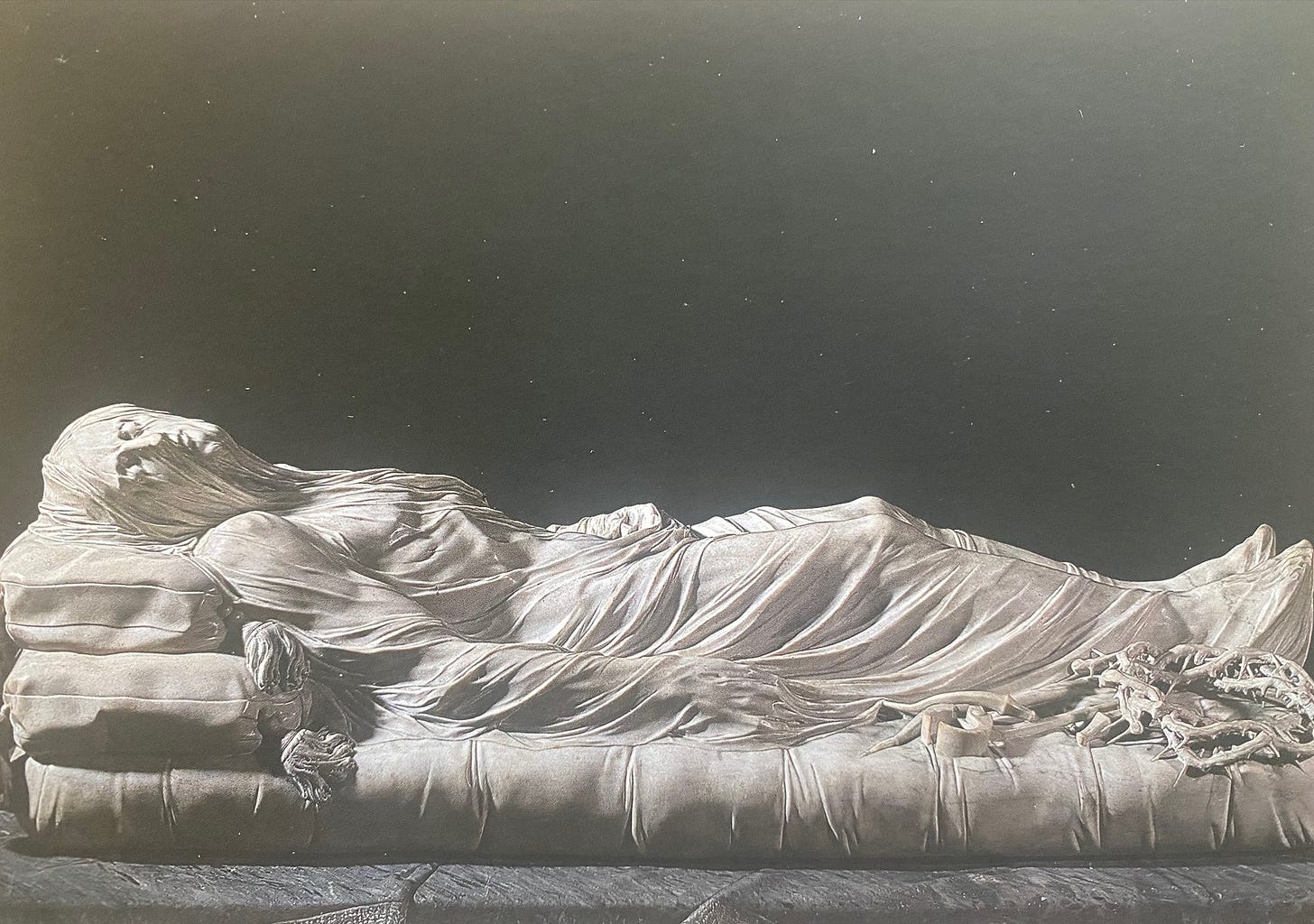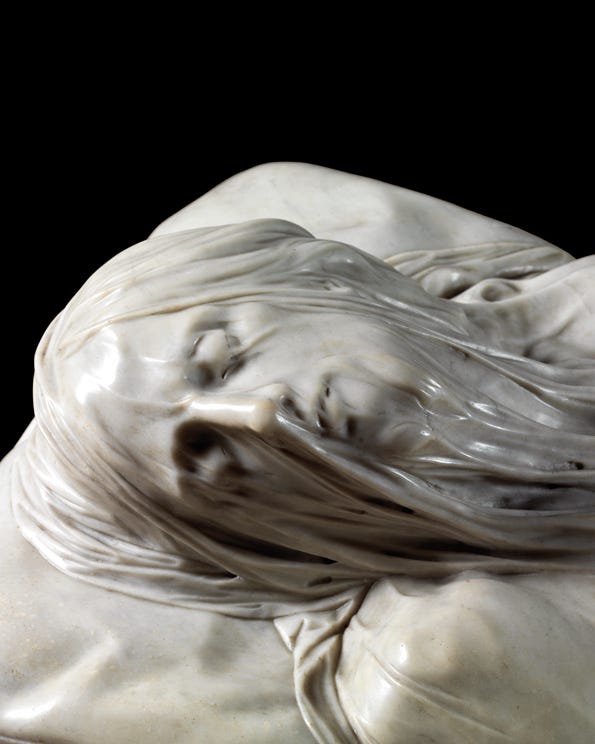If you enjoy reading this piece, please like it and share it. So more people get to read it. Thank you.
The Veiled Christ, Sansevero Chapels, Naples, Italy
Last weekend, while walking in the park, I listened to Bari Weiss’ interview with Rick Rubin, a well-known music producer. Rubin said something shocking, “The Beatles prove the existence of God.” I’m afraid I must disagree with Rubin’s assessment despite being a Beatles fan. Yet, I do share his sentiment that great art, whether a painting, sculpture, or music, can be so awe-inspiring and profoundly affect us that it seemed the artist was led by the hand of God.
My husband and I traveled to Southern Italy recently. We visited the ruins of Pompeii, traveled to the coast of Sorrento, and spent some time in Naples. I will have more to say about those other places, but today I want to share my Naples experience with you.
In Rick Steve’s guidebook, he wrote, “Naples is Italy in the extreme…it is Italy’s third largest city and Europe’s most densely populated city, with more than one million people and few open spaces or parks… in many ways, it feels like an urban jungle…” Such a description of Naples is spot on. Naples reminds me of a third-tier city in China – its streets are narrow, dirty, and crowded. The outside walls of many churches in Naples are covered with graffiti, while the interiors of those same churches are not as elaborately decorated as those in Rome and Florence. Naples is an acquired taste for Americans who are used to wide, clean streets and lots of personal space.
The street of Naples, Italy
But Naples does have its charm. For example, the city probably has the best street foods in Italy – the locals seem to have learned long ago to make delicious snacks simply by frying everything from cheese to seafood. It is common to see people walking on the street while eating snacks on sticks or from cone-shaped paper wraps. My favorite street food in Naples is fried mozzarella cheese – by the way, Naples boosts the best mozzarella cheese in Italy.
Fried mozzarella cheese
In terms of sightseeing, Naples Archaeological Museum is a must-seeing. But if you don’t plan to spend much time in the city, the one thing you shouldn’t miss is visiting the Veiled Christ at the Sansevero Chapel Museum. The museum, which was a chapel, is in the city’s historic part of the town. Also known as Santa Maria della Pieta, the Sansevero Chapel was built in the late sixteen century and served as a family chapel for Raimondo di Sangro, the seventh Prince of Sansevero. Raimondo was a luminary of his time and wore many hats, including scientist, inventor, patron of art, and the grandmaster of the Freemasons of the Kingdom of Naples. His family chapel, although small, is filled with priceless art. The best-known piece is a sculpture called The Veiled Christ.
According to the legend, Raimondo wanted to turn one piece of marble slab into a sculpture of the life-size Jesus’s body after the crucifixion and covered by a thin shroud. Raimondo first commissioned Antonio Corradini to do the work. Unfortunately, Corrandini died after only finishing a terracotta model of the sculpture. Raimondo turned to a young artist named Giueseppe Sanmartino (1720-1793). Discarding Corrandini’s original design, Sanmartino delivered The Veiled Christ in 1753, instantly becoming one of the world’s best-known masterpieces.
Today, the sculpture lies in the center of the Sansevero Chapel. The veil (caved out of marble) covering Christ’s body is exceptionally thin and almost translucent. Even though it wraps Christ’s entire body, it hides nothing underneath it. We could see all the incredible and realistic details of Christ’s body and his suffering the artist had captured and reflected –the indentations on the pillow that Christ’s head laid and the nail holes in his hands and feet. The artist even captured the swollenness of Christ’s feet. Also, the veins on Christ’s feet are evident. It seemed no detail was too small for Sanmartino.
I couldn’t believe that this sculpture was created by someone with no electrical tools and was made from marble, one of the hardest materials in the world. According to the legend, since the sculpture was unveiled to the public, “some thought that the unbelievably transparent, embroidery-adorned veil could have only been created through alchemy due to its undeniable perfection and life-like quality.”
The Veiled Christ sculpture coveys such breathtaking beauty and perfection that I could feel strong emotions stir inside me when I stood next to it. Most incredible is that although a veil covered Chris’s face, it seemed his expression changed from pain to peace as I walked closer. I couldn’t take my eyes off his face and had a strong urge to kneel and pray. As I looked around and noticed the expressions of people around me, I was almost sure I wasn’t the only one with such a reaction.
French novelist Andre Gide once said, “Art is a collaboration between God and the artist.” I do not doubt that the holy spirit was guiding Sanmartino’s hands as he was chiseling this marble and turning it into an awe-inspiring image of God that would touch millions of souls that came to its presence, including mine.
This Easter, as we celebrate Christ’s resurrection, let’s not forget that God is the greatest artist, and we are all his instruments. Although few of us have the kind of talent Sanmatino possessed, we can still honor and glorify God in our daily lives by utilizing the skills he grants us and his gift of time. Alistair Begg, the senior pastor of Cleveland’s Parkside Church, reminds us, “There is no one who is insignificant in the purpose of God.” So, open your heart to God, hold His hand, invite Him to be your collaborator, and let Him guide you to create something beautiful on life’s canvas.
Happy Easter!









The collaboration comes full circle when the artist returns with all praise to God, and brings along admirers like me. Thank you artist Helen!